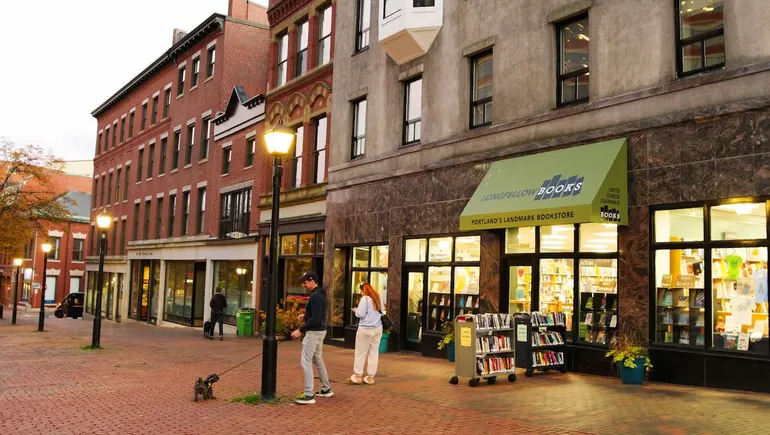Retail is in yet another period of upheaval: A trade war is roiling consumers, enabling inflation and fueling speculation about a recession. Yet in many ways the industry has also entered a period of stability, according to a report Monday from commercial real estate firm Colliers.
This is because e-commerce is no longer the destablizing force it once was.
In the last 15 years, the value of in-store sales declined just once, in 2020, amid pandemic lockdowns, according to research from two U.S. Colliers analysts, Anjee Solanki, national director of retail services and practice groups, and Nicole Larson, manager of national retail research. Physical stores still account for over 76% of core retail sales and, while e-commerce’s share continues to grow, the once-torrid pace of that growth has eased, they said.
“The real retail reality is that while headwinds like tariffs and store closures persist, the disruption from e-commerce appears largely behind us,” Solanki said by email.
One reason for this is the realization on the part of direct-to-consumer brands — including some that at one point achieved unicorn-levels of investment — that stores are a critical channel, whether they run them or sell via wholesale to other retailers. Even some established brands like Nike have had to relearn the value of partnering with legacy retailers.
Another is that many traditional retailers knocked off balance by the rise of Amazon, and online commerce in general, long ago established their own e-commerce. In fact, with consumers expecting to be able to make purchases and returns on or offline, retailers running stores are often at an advantage, according to Colliers. In 2024, stores were integral to about a third of online retail sales via fulfillment like pickup or ship-from-store — a milestone reached a year earlier than those researchers predicted — and in five years that is set to rise to over 36%.
Brick and mortar continues to dominate
% of core retail sales by channel
Stores have also emerged as an important channel for returns, which have increased due to e-commerce. Returns were projected to land at $890 billion in 2024, equal to roughly 17% of retailers’ annual sales, according to a report from the National Retail Federation. Whether to handle returns in stores, outsource to a third party or offer a hybrid of the two “depends on a retailer’s format and priorities,” Solanki said.
“Returns are a key part of the omnichannel experience but handling them in-store requires balancing customer engagement with operational efficiency,” she said. “While in-store returns can drive additional sales and reinforce brand control, they also take up valuable space, potentially limiting revenue per square foot. Outsourcing to third party logistics providers may reduce costs and free up store resources, though it sacrifices direct customer touchpoints.”
Plenty of retailers have shrunk their store fleets in recent years, especially during and after bankruptcies. Last year, Big Lots expected to close its remaining 870 stores, after closing several hundred earlier in the year. Due to their bankruptcies this year, Joann is closing its roughly 800 stores and Party City is closing its 700 or so.
“Although store closures are happening, they’re tied mainly to operational challenges or oversaturation, rather than displacement by e-commerce,” Solanki said.
Others, including international brands new to the U.S. market, are also keen to sign new leases. A couple hundred Big Lots stores have reopened under new ownership, and Burlington alone, which aims to add about 100 stores to its fleet each year, has snapped up 45 Joann leases. In Q1, the national vacancy rate was just 4.2%, and “shopping center occupancy hit a decade-high peak,” according to Colliers.
In the U.S., between 2018 and 2023, more than 18,900 stores opened, more than 5,000 of them by foreign companies, Colliers said.
Opening a store is just the beginning, however, as the customer experience remains essential, Solanki said.
“The role of brick-and-mortar has evolved beyond transactions,” she said, adding that retailers investing in experiential elements, store design and digital tools are better able to drive loyalty and conversion. “To stay competitive, brands must continuously reimagine the in-store experience as part of a seamless omnichannel strategy that meets rising consumer expectations across every touchpoint.”
Neither stores nor e-commerce may be enough in the era of tariffs, though, given the higher cost of goods combined with the price sensitivity of consumers, per Colliers’ report. “Retailers will look to bolster revenue streams from outside of retail to help support both the top and bottom lines,” the researchers said.
If tariffs continue or a recession hits, some retailers “may face sustained margin pressure,” but today’s low vacancy rates mean that fewer landlords may be amenable to revisiting leases, as many were during the pandemic, Solanki said.
“Still, selective requests may emerge from smaller or discretionary-based tenants, who are most exposed to cost increases,” she said. “As market conditions evolve, new developments may occur every day, requiring both retailers and consumers to pivot. Landlords must remain attentive and responsive to these shifts to stay aligned as they negotiate and manage leases.”


